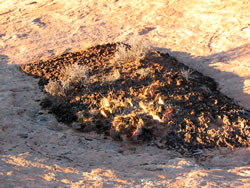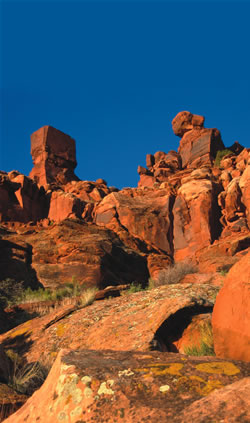Hiking Happenings November
2006
The Guard
and The Guardian
by Rory Tyler
Every society makes psychological connections
between its culture and land. Consider the names we apply
to some local Moab landmarks - Dark Angel, The Windows, Island
in the Sky, The Penguins. When we see these landforms we
easily comprehend the significance of the names. However,
angels, windows, islands, and penguins probably did not have
a high psychic profile for the Colorado Plateau’s ancient
desert tribes.
Still, the Ancients likely engaged in this naming activity.
It is even possible that they carried the exercise further,
imbuing entire landscapes with meaning, purpose, mythology,
and ritual. One place this might have happened is in Hidden
Valley.
To get to the Hidden Valley trailhead, go three miles south
of Center and Main on Hwy 191. Just past the stucco dental
clinic, turn right on Angel Rock Road, then right on Rimrock
Lane. The trail climbs three hundred feet to Hidden Valley
then rolls along an easy mile and a half to a pass overlooking
Poison Spider Mesa and Island in the Sky. Up and to the right
of the pass you’ll see a cliff face, the outside wall
of a horseshoe-shaped formation, which is a remnant of an
ancient stream meander. The south facing walls of the horseshoe
are loaded with Indian rock art. Walking time to the rock
art is about ninety minutes.
Basketmaker Indians created most of the rock art in Hidden
Valley between one and two thousand years ago when they dominated
the Moab area. Masculine themes of hunting and fighting prevail.
The Basketmakers used a spear-throwing device, called an
atlatl, until about 500 A.D. when bows and arrows were introduced.
Hidden Valley has numerous depictions of human figures with
their arms cocked, legs akimbo, throwing spears at deer,
elk, and sheep. There are also several panels depicting hand-to-hand
combat.
Archeologists have discovered a great deal about violence
in the Southwest. Lately, there’s been speculation
that some of it may have occurred in the form of ritual warfare.
Ritual warfare occurs throughout the world’s anthropological
record. Combatants choose a time and place, devise a set
of rules, then engage in hostilities until they achieve certain
results. These results range from simply striking an opponent
and returning safely to friendly territory, known as ‘counting
coup’, to the capture, injury, or death of the enemy.
Basketmaker Indian culture also dominated the San Juan River
Basin, a hundred miles south of here. While there are many
similarities in Moab and San Juan rock art, there are also
notable differences. Moab panels frequently include a figure
with a single long appendage coming off the head. I call
him the Cat-in-the-Hat. Around the San Juan a common motif
is a figure with a bird-shaped head. I call him the Duckhead.
One interesting image in Hidden Valley depicts a Cat-in-the-Hat
and a Duckhead in the act of hurling atlatls at each other.
Moab versus Blanding. Some things never change.
When you get to Hidden Valley you’ll see that it is
a great place for contests like capture-the-flag and ritual
spear fights. As I considered this idea, I kept thinking
about two distinctive stone formations at the foot of the
valley. One looks like a human head facing south towards
San Juan country. To his left is a blocky fellow of imposing
stature. Of course, what the Basketmakers thought of these
two towering presences we can never know. But I enjoy speculating
that the first figure was seen as some sort of lookout, keeping
an eternal eye open for trouble from the south. His partner,
the big blocky fellow, reminds me of a middle linebacker.
Maybe he’s not the brightest torch in the bonfire,
but when you need a brute to lay a little science on the
bad guys, he’s your man. I call this duo The Guard,
he’s the big blocky guy, and The Guardian, who keeps
watch, sounds the alarm, and deploys the troops as needed.
Based on recent research and concepts in Southwest archeology,
I think it’s a plausible hypothesis to place the formations
and rock art of Hidden Valley into an anthropological context
that includes ritual warfare. Take a hike and see what you
think.
Rory Tyler is available
for cowboy poetry/campfire song gatherings which include
lore, science, history and lies of the Moab area. (Suitable
for all age groups). Rates are negotiable. Give Rory a
call at 435-260-8496
|
Biological
Soil Crust (aka)
Cryptos (krip’ tose):
The surface of
Moab’s desert is held together by a thin skin
of living organisms known as cryptobiotic soil or
cryptos. It has a lumpy black appearance, is very
fragile, and takes decades to heal when it has been
damaged. This soil is a critical part of the survival
of the desert. The cryptobiotic organisms help to
stabilize the soil, hold moisture, and provide protection
for germination of the seeds of other plants. Without
it the dry areas of the west would be much different.
Although some disturbance is normal and helps the
soil to capture moisture, excessive disturbance by
hooves, bicycle tires and hiking boots has been shown
to destroy the cryptobiotic organisms and their contribution
to the soil. When you walk around Moab avoid crushing
the cryptos. Stay on trails, walk in washes, hop
from stone to stone. Whatever it takes, don’t
crunch the cryptos unless you absolutely have to! |

Cryptobiotic soil garden
|
|
|

